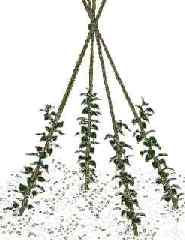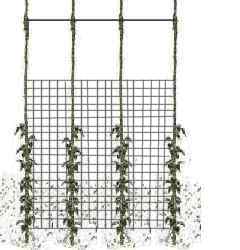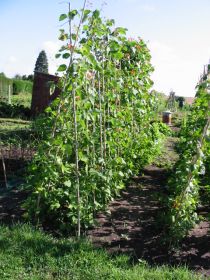 The ideal plant for the beginner gardener. If the soil is prepared well with lots of compost, runner beans are very forgiving vegetables. The foliage is attractive, and the red or white flowers making this a beautiful garden feature.
The ideal plant for the beginner gardener. If the soil is prepared well with lots of compost, runner beans are very forgiving vegetables. The foliage is attractive, and the red or white flowers making this a beautiful garden feature.
Runner beans prefer a position in full sun, although they tolerate part shade very well. Because of their height, they should not be grown in areas exposed to winds, they will easily be blown over.
Remember also that their foliage is very thick and this results in them casting deep shade over a wide area. Useful for some vegetables but not so good for others.
Part of the 'legume' family of vegetables, runner beans are able to extract nitrogen from the air and fix it in little nodules on its roots. For this reason, the soil should not be rich in nitrogen, which would only result in lots of leafy growth and few beans. The ideal soil is deeply dug with lots of well-rotted organic matter (peat or peat substitute is ideal) incorporated. This will ensure that the soil is capable of holding lots of water, a key need of runner beans.
If unprotected, Runner Beans are in almost all cases damaged by any degree of frost. Where the seedlings have appeared above the soil surface and a late unexpected frost strikes, it is best to remove them and plant more seeds in their place. The best time to plant Runner Beans outside is a week before the last frost.
Cloches or supported plastic will protect them if a late frost is predicted, as will plastic bottles with the bottom cut off placed over the seedlings. The other alternative is to sow the seeds in peat pots and initially grow them on the windowsill until all danger of frost has passed and then plant them, peat pots and all, directly into the ground. Remember to soak the peat pots in water prior to planting so that they will quickly break down in the soil.
A good tip for extending the cropping season of runner beans is to sow half the seeds indoors or in a greenhouse. When you come to sowing time, sow the seeds as normal on one side of the row and plant the indoor reared plants on the other (see picture on right). The indoor grown plants will crop first, followed by those sown directly in the ground a couple of weeks later.
Runner Beans can be given a head start (about four weeks) by sowing them inside and / or under cloches. Simply place the poly-tunnel in position two weeks before sowing (to warm up the soil), then sow the seed three or four weeks earlier than normal.
Runner Beans can be given a head start (about four weeks) by sowing them inside and / or under cloches. Simply place the poly-tunnel in position two weeks before sowing (to warm up the soil), then sow the seed three or four weeks earlier than normal.
Supporting Runner Beans
Runner beans grow to about 1.8m (6 foot) high and they definitely need support. The idea is to provide a structure which their tendrils can grow round and pull the plant up.
Runner beans grow to about 1.8m (6 foot) high and they definitely need support. The idea is to provide a structure which their tendrils can grow round and pull the plant up.
 The most attractive form of support is a wigwam - four or five bamboo canes tied together at the top will be sufficient. The growth at the top will be a bit crowded, but this structure will still produce a good crop of beans.
The most attractive form of support is a wigwam - four or five bamboo canes tied together at the top will be sufficient. The growth at the top will be a bit crowded, but this structure will still produce a good crop of beans.
It is a good idea to twist some gardening twine round the bamboo canes, this will give the growing plants more to grab hold of.
Where space is really short, this type of structure can be used for container growing runner beans. In this case, insert one cane centrally in the container, tie six or so lengths of garden twine to the top of the cane and secure the other ends of the twine to the edge of the container. Plant three or four seeds, which will then grow up the twine. The plants will need their tips pinching out when they reach the top of the twine.
Other methods are to erect a criss-cross of canes, each pair tied together at the top, or simply a line of canes connected together with mesh netting. Both are illustrated in the diagrams below. Finally, don't forget that runner beans can be be grown up an existing fence which has been covered with mesh netting.
Caring For Your Runner Beans
The requirements of runner beans are simple - water and weeding, possibly some feeding. All three can be accomplished by a mulch of organic material spread round the plants - this will help retain moisture, keep the weeds down and gently feed the plants. If the soil has been prepared as described previously the only other attention is hand watering in very dry conditions, especially as the flower buds begin to develop. Finally, pinch out the growing tips when the plants reach the top of the supports.
 A single row of canes with plastic mesh |
 Row of canes support |
Caring For Your Runner Beans
The requirements of runner beans are simple - water and weeding, possibly some feeding. All three can be accomplished by a mulch of organic material spread round the plants - this will help retain moisture, keep the weeds down and gently feed the plants. If the soil has been prepared as described previously the only other attention is hand watering in very dry conditions, especially as the flower buds begin to develop. Finally, pinch out the growing tips when the plants reach the top of the supports.




0 comments:
Post a Comment